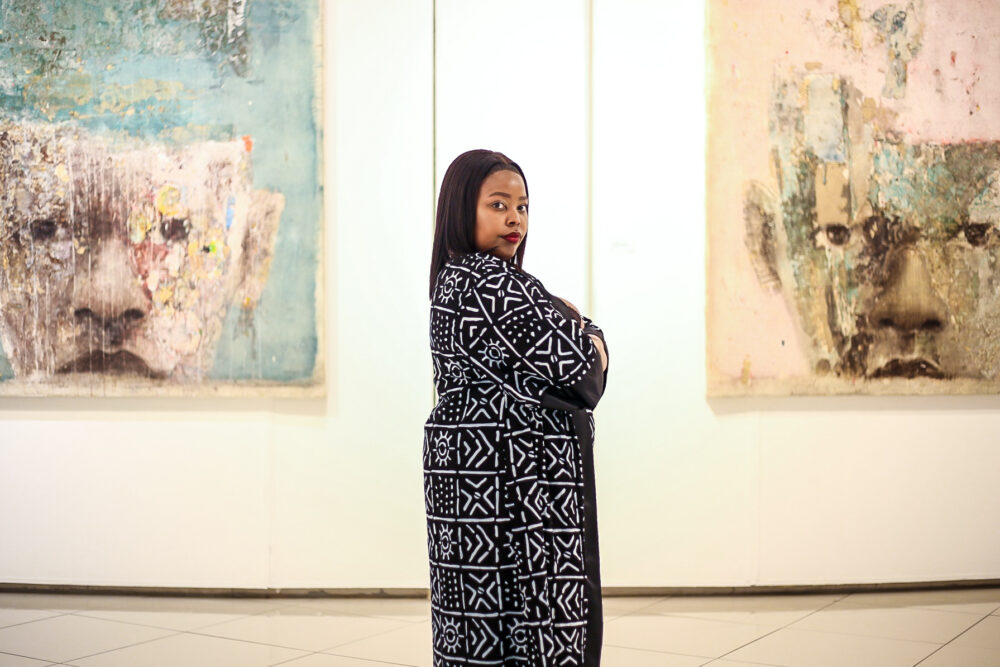Female first: Tshegofatso Seoka, curator of the Unisa Art Gallery, in the Kgorong Building, Pretoria, says that she prioritises acquiring works by women artists, and she emphasises the importance of institutions sharing resources.
To approach the Unisa Art Gallery, housed in the aptly named Kgorong Building, is to navigate a landscape of permissions.
The word “Kgorong”, meaning “meeting place” in Setswana, contrasts sharply with the cones and boom gates where vigilant security probes every vehicle’s purpose.
Yet within this architecture of barriers, Tshegofatso Seoka has created something extraordinary — a sanctuary where access to African consciousness requires no special clearance.
“It really felt like a dream come true and a homecoming of note,” Seoka reflects on her appointment as curator a few years ago.
Today, she moves through the gallery with assured composure and sartorial confidence, having transformed it into a dynamic cultural epicentre.
Initially trained in fine arts, Seoka discovered her passion lay, not in producing art, but in interpreting its deeper meanings within the African artistic landscape.
Her curatorial philosophy emerges from lived practice, shaped by an unconventional trajectory through South Africa’s art institutions.
“I’ve always been more concerned with the greater meaning of artworks and what they sought to communicate about the artist — their experiences and thought processes,” she explains.
Seoka’s formative training at Pretoria Art Museum, under Mmutle Kgokong, followed by various institutional roles, prepared her for this pivotal position.
This background informs her approach to exhibitions, which she describes as contributing to everything from “postcolonial conversations on decoloniality, Africanism and continental diversity” through to thoughtful programming and strategic acquisitions.
Under her stewardship, the gallery has hosted exhibitions that trace South Africa’s complex narrative while amplifying previously marginalised voices.
Her inaugural exhibition, 2023’s Being and Becoming, marked the university’s 150th anniversary by exploring ontology through works from Gerard Sekoto, Helen Mmakgabo Sebidi and Senzeni Marasela.
Its philosophical foundation found a political counterpart last year in We the Purple, which examined democracy through the lens of black womanhood in collaboration with The Javett Art Centre at the University of Pretoria.
“It was imperative for me to open dialogue on notions of democracy through the experiences of the black women of South Africa,” Seoka emphasises, referencing an exhibition that featured Tracey Rose, Mary Sibande, and Nandipha Mntambo.
Introspect II celebrated Thonton Kabeya’s decade in South Africa through sculpted canvas works. Place and Practice highlighted various methodologies and creative processes, drawing from pioneering art centres such as Rorke’s Drift, Mmabana, Polly Street and Funda.
Earlier this year, Tsalwa: The Materiality of Stories explored indigenous knowledge systems through the traditional straw mat (xitheve) as a living archive of memory.
These exhibitions reflect Seoka’s exploration of South Africa’s past and present, ensuring previously marginalised voices are seen and heard through innovative curatorial strategies and community engagement.
Her approach balances scholarly rigour with accessibility, which is a principle reflected in her evolving collection strategy.
“Largely influenced by my advocacy for women of colour and their lived experiences, I emphasise collecting and acquiring artworks from women artists,” she explains, citing acquisitions of Talia Ramikwalan, Ruth Motau, Haneem Christian, Lindokuhle Sobekwa, Mary Sibande, Katlego Tlabela and Patrick Rulore. She also seeks internationally recognised artists such as Yinka Shonibare, Teresa Firmino Kutala, Dada Khanyisa, and Eddy Kamuanga to broaden the representation of African voices.
The gallery navigates institutional challenges, including limited staff and resources. Yet Seoka maintains “an honest, open-door policy based on truthfulness and transparency,” seeing collaboration as vital to transforming her gallery and the wider cultural sector.
As a university gallery, Unisa’s fosters an intersection where scholarship, practice and lived experience meet. The forthcoming Masters and Doctoral Exhibition: Thresholds of Knowledge, curated by Professor Nombeko Mpako, exemplifies this ethos. Opening on 20 September and running until 17 October, it will transform the gallery into a site of dialogue, where interactive installations and performative encounters allow indigenous languages and embodied practices to amplify diverse experiences.

Rather than presenting a static display, Thresholds of Knowledge positions the gallery as an environment of inquiry, exploring how creative practice can inform knowledge, foster understanding and spark new futures.
In Seoka’s hands, the gallery becomes “a visual archive representative of a pan-African institution of higher learning”. Her vision extends beyond its walls, engaging communities around Tshwane, including Soshanguve, Garankuwa, Atteridgeville, Mabopane and Mamelodi, through public programming.
She also aims to create “a safe space where practitioners can learn, engage, and develop their voices” through mentorship and professional development.
In this landscape of institutional barriers, Seoka has created a radical cultural space where curiosity is the only credential. True to the building’s name, she has made this meeting place accessible to all who seek meaningful engagement with African art and ideas.
“A prosperous African art sector can be achieved through a willingness to share resources and knowledge between institutions,” Seoka concludes.
By holding this gateway, she is not merely guarding artworks but keeping doors open for a new generation of African creative expression.
The Unisa Art Gallery stands as a beacon of pan-African artistic excellence and scholarly innovation, inspiring both the academic community and the broader public.